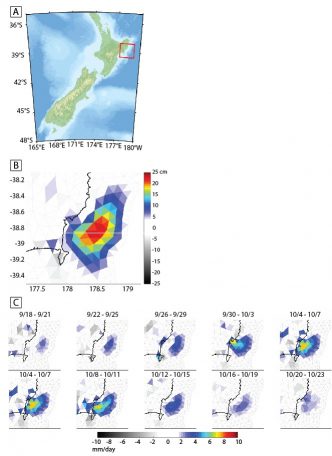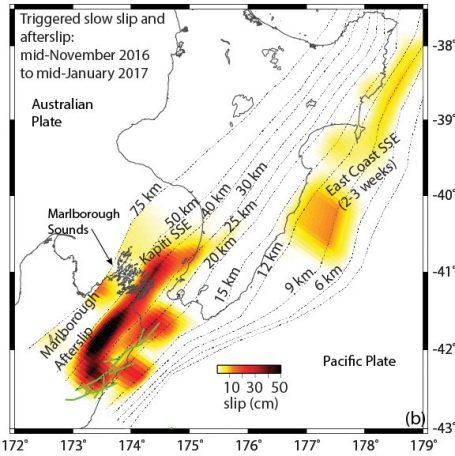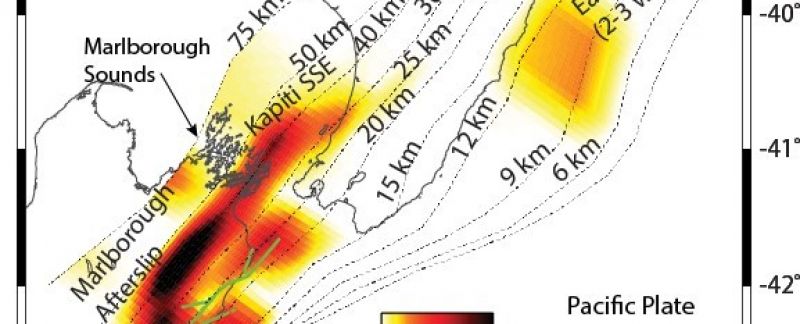Noel Bartlow (University of Missouri), Laura Wallace (UT Austin & GNS Science), Ryan Yohler (University of Missouri), and Charles Williams (GNS Science)
The New Zealand and Cascadia subduction zones are two GeoPRISMS primary sites that have captured the interest of geophysicists from around the world. Both subduction zones feature significant geological hazards, including the potential for large earthquake ruptures and tsunamis. In New Zealand, the capital city of Wellington sits directly atop a large patch of the main subduction plate interface which is frictionally locked, with the potential to rupture in future earthquakes. In Cascadia, there is also potential for a large earthquake on the main subduction interface, which may impact cities such as Portland, OR and Seattle, WA.
Both New Zealand and Cascadia also host slow slip events (SSEs). Slow slip events consist of slip on the subduction plate interface – just as would occur in an earthquake – except the slip takes place more slowly than it would during an earthquake. Now that slow slip events are widely recognized at many subduction zones, it is critical to better understand their role in the accommodation of plate motion. Many questions also exist regarding implications of slow slip for subduction zone mechanics, and the relationship between slow slip events and seismic slip events on the plate boundary.
In New Zealand, slow slip events have been shown to trigger regular earthquakes up to magnitude 6 (e.g. Wallace et al., 2017). Additionally, some evidence exists from the 2011 Tohoku-Oki Mw 9.0 earthquake (e.g. Ito et al., 2013) and the 2014 Mw 8.1 Iquique earthquake (Ruiz et al., 2014) that slow slip events may be able to trigger damaging megathrust events. Most slow slip events do not trigger earthquakes and we currently cannot differentiate slow slip events that might trigger large earthquakes from those that will not. It is possible, however, that further study will lead to methods that allow slow slip events to be used as reliable earthquake precursors.
PIs Noel Bartlow (Univ. of Missouri) and Laura Wallace (UTIG), along with collaborator Charles Williams (GNS Science New Zealand) and graduate student Ryan Yohler (Univ. of Missouri) are studying slow slip events and frictional locking in New Zealand and Cascadia.
One goal of the project is to create self-consistent catalogs of slow slip events in both subduction zones that capture the time varying behavior of slow slip, including how these events grow and decay and move along the subduction plate interface. The data used for these models consists of land-based geodetic GPS time series, and in New Zealand, we also use vertical deformation of the seafloor recorded for one slow slip event using absolute pressure sensors (Wallace et al., 2016).
Previous time varying slow slip event modeling studies usually assume a uniform, elastic half-space (e.g. Bartlow et al., 2014). These new models utilize spatially-varying elastic properties within the earth based on seismic velocity models in both New Zealand and Cascadia, calculated using the PyLith finite element code. This leads to more accurate models of slip during slow slip events, and therefore, more accurate estimates of the amount of slip taken up in slow slip as opposed to being available for release in future earthquakes. Preliminary models for both New Zealand (Williams et al., 2017) and Cascadia (Bartlow et al., 2017) were shown at the American Geophysical Union 2017 Fall meeting. Additionally, a time-dependent model incorporating both onshore GPS and offshore pressure measurements for the 2014 Gisborne, New Zealand slow slip events was shown at the meeting by graduate student Ryan Yohler (Yohler et al., 2017). This model is shown in Figure 1. This slow slip event occurred near the locations of two historical 1947 earthquakes that caused damaging tsunami waves. This is the first time that seafloor geodetic data have been used in a time-dependent deformation model.
As part of this project, a team led by Laura Wallace, including Bartlow and other collaborators, have recently reported the occurrence of a large, shallow (<15 km), two-week slow slip event at the Northern Hikurangi margin triggered dynamically by passing seismic waves from the November 2016 magnitude 7.8 Kaikōura earthquake, over 600 km away (Fig. 2; Wallace et al., 2017). Long-duration (>1 year), deep (>25 km) slow slip was also triggered at the southern Hikurangi margin (Kapiti region), and afterslip occurred on the subduction interface beneath the northern South Island of New Zealand (Fig. 1).
Triggered slow slip at southern Hikurangi is more likely due to large static stress changes induced by the Kaikōura earthquake, given that area’s closer proximity to the earthquake (Wallace et al., 2018). Prior studies had already identified cases of slow slip events triggering earthquakes, and nearby earthquakes prematurely stopping ongoing slow slip events, but these studies are the first to show that dynamic and/or static stress changes from passing seismic waves may also trigger large-scale, widespread slow slip events. We are still discovering the wealth of possible complex interactions between slow slip events and earthquakes, and what they might mean for hazards. ■



